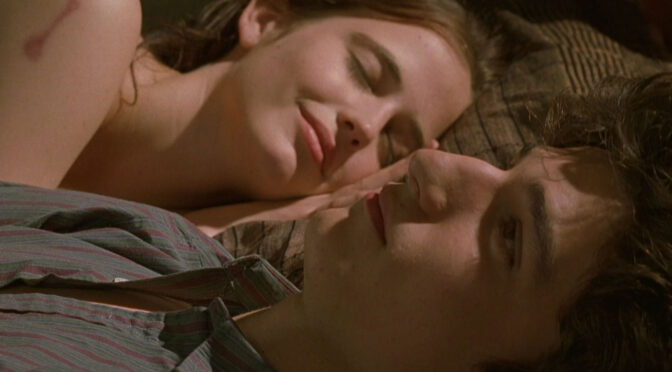Eroticism thrives on presence. It happens in the moment—in the body, in the gaze, in the tension between movement and stillness. This is precisely what makes erotic films so instructive for writers: they show what happens instead of explaining it. They work with postures, touches, perspectives. And it is precisely these tools that can give your writing new depth—if you use them consciously.
A glance, a breath—how film inspires erotic storytelling
When writing erotic scenes, we often think first about the plot: Who wants whom, what happens next? But before anything happens, we already feel everything in the film—through the characters’ bodies. Their tension, their shame, their desire.
A camera needs no explanation: it simply stays on the face of a woman whose breathing quickens. On her chest, which rises. On the inner surface of her thighs, which open involuntarily as she hears a voice.
As an author, you don’t have a camera. But you have words that can focus like a zoom lens. Words that create closeness, set perspectives, scan a space like a dolly shot. This doesn’t work through reflections or flashbacks – but through the conscious description of what is visible in the moment.
Nudity as staging – not as explanation
Many novice writers use flashbacks to provide psychological background: Why is she ashamed? Why does she hesitate? Why does she recoil when her breast is touched?
The body itself often provides the answer – if you take it seriously.
In Lars von Trier’s Nymphomaniac, a woman lies on a rumpled bed. Her vulva is visible, framed frontally in the shot. Her breathing is shallow, her gaze averted. Her body is exposed, but at the same time withdrawn. As a writer, you can’t “take over” this scene, but you can translate it:
“Her thighs lay open, without seeming inviting. The skin between her labia glistened with moisture, but felt cool. Her right hand lay motionless on her stomach. Only her breath—shallow, jerky—betrayed that she was still there.”
This type of description does not judge. It does not tell a backstory. It simply shows. And that is enough – if it is done well.
From the screen to the page – film scenes as a writing exercise
If you want to write cinematically, you have to learn to think visually. That means observing film scenes closely and asking yourself: What do I see? And then: How can I describe this in words so that it has the same effect when read?
An excellent exercise is to choose a specific scene from a film and translate it into literature. Not a clumsy retelling, but a sensual, physical description from the perspective of one of the characters involved. Force yourself to go into detail when writing. Plan at least one standard page for every minute of film. This will help you start paying attention to small details. In film, there are no coincidences.
An example: In The Dreamers, a young woman stands naked in the kitchen. Her brother is peeling an orange. Her pubic hair is visible, her nipples are hard, her stomach is relaxed. No one talks about her nakedness. But it’s there, in the picture, in the room, between the siblings.
A literary approach might look like this:
“Isabelle reached for the spoon without putting anything on. Her stomach was still damp from the shower, a small bead of water ran over the fuzz above her pubic area. Theo peeled the orange with a calmness that seemed almost artificial. The smell of citrus mingled with the scent of warm skin.”
The body is not judged. It is simply there. And thus becomes the central medium of the narrative.
Writing with the body, not with the head
In literary erotica in particular, it is often the non-cinematic elements that cause readers to skip pages. The theoretical discussions about love in Emanuelle Arsan’s “Emanuelle” were considered rather annoying by many reviewers – even those who otherwise devoured the novel. The same is often true of long monologues. What makes the story tangible are the emotions conveyed by the scene. Bodies speak—through movements, posture, glances. If you want to write like a director, you have to learn to immerse yourself completely in a scene. To think about what you want to communicate—and how you can make it visible.
Where are the characters standing? How much skin are they showing? What are their hands doing? How are their bodies reacting? What does the room smell like, how does the air feel on your skin?
Writing prompt
Choose a scene from a film that you found erotic or disturbing. Describe it in literary terms. Refrain from putting the protagonists’ thoughts into words. What can you see in the scene in terms of action, interactions, and decor? Focus on the bodies, the touches, the movements, the sounds. Also describe the intimate parts of the body, as far as they are visible. Describe them sensually and precisely. Bring the scene to life for someone who doesn’t know it—with everything that makes it what it is.

